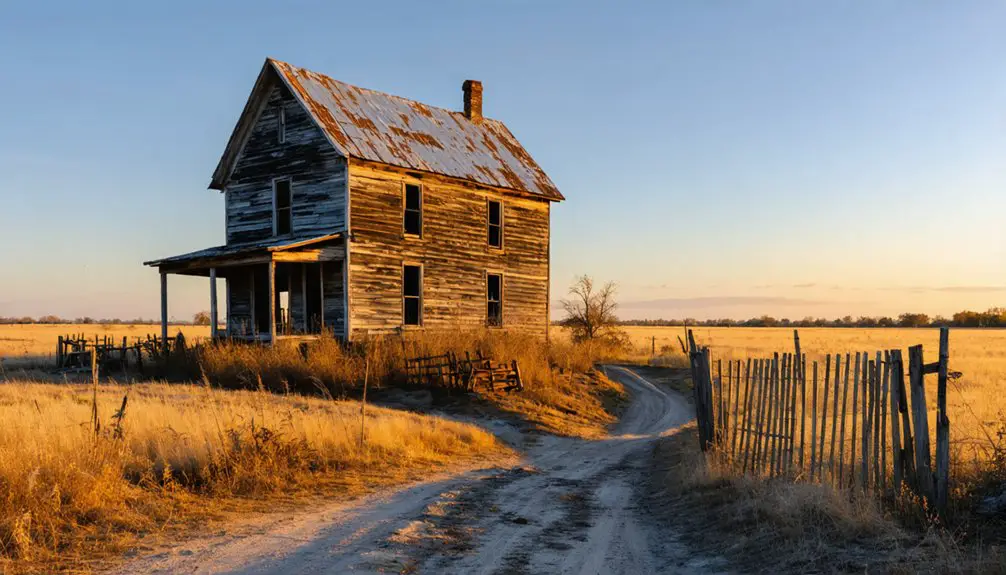You’ll find Eschiti among Oklahoma’s 2,000 ghost towns, established in 1907 during the Big Pasture settlement rush. Named after a Comanche chief, the town quickly grew to include 20 businesses, including cotton gins and a bank. Its rivalry with nearby Kell City and lack of railroad access led to its decline when Grandfield emerged in 1909. Today, the well-maintained Eschiti Cemetery stands as the primary reminder of this “Princess of the Pasture’s” frontier legacy.
Key Takeaways
- Eschiti was established in 1907 in Oklahoma’s Big Pasture region and named after a Comanche chief before becoming a ghost town.
- The town’s decline began when railroad promoters bypassed Eschiti for nearby Kell City, limiting transportation and economic opportunities.
- Competition with Kell City and Grandfield’s establishment in 1909 led to population exodus and business relocations.
- Poor water quality and the loss of essential services contributed to Eschiti’s abandonment, making it one of Oklahoma’s 2,000 ghost towns.
- The Eschiti Cemetery remains as the primary physical reminder of the town, now maintained as part of the Grandfield Cemetery system.
The Birth of a Big Pasture Town
When the Department of the Interior opened the Big Pasture for settlement in 1907, Eschiti emerged as one of several government-planned townsites in Oklahoma Territory.
You’ll find its origins deeply rooted in Eschiti heritage, named after a Comanche chief – a reflection of the area’s Native American legacy.
The town’s official birth came on October 31, 1907, when Hiram F. Cruble established the post office in the north half of section 3, Township 4 south, Range 14 west I.M.
Like many early settlers, you’d have witnessed the rush of optimistic buyers snapping up lots, convinced the railroad would transform Eschiti into a bustling hub.
By 1908, twenty businesses and services had established themselves in the growing community.
A devastating fire in 1907 struck the town, marking the beginning of its eventual decline.
The Comanche influence remained strong in this region, which was part of the 488,000-acre Big Pasture previously reserved for tribal grazing.
Early Days and Economic Growth
The initial economic footprint of Eschiti took shape rapidly after its founding, with approximately 20 businesses establishing themselves by 1908. You’d have found essential services including a bank, two doctors, and an undertaker serving the growing community. The founding vision emphasized economic diversity, reflected in the range of establishments that emerged.
Cotton played a central role in the town’s development, with two cotton gins processing the region’s agricultural output. You could’ve conducted your financial affairs at the local bank, sought medical care from resident physicians, and processed your cotton harvest all within the town limits. Like many mining and boomtowns across Oklahoma, the community’s prosperity was closely tied to its natural resources. The town’s location within Southern Plains territory connected it to the rich cultural heritage of Comanche and Kiowa peoples.
The post office‘s establishment further cemented Eschiti’s position as a legitimate settlement, creating a hub for commerce and communication in Oklahoma’s Big Pasture region.
Railroad Rivalry With Kell City
Despite Eschiti’s early success, a fateful decision by railroad promoters Frank Kell and Joe Kemp would spark an intense rivalry that shaped the region’s future. The two businessmen deliberately bypassed Eschiti, establishing their own settlement, Kell City, two miles away along the Wichita Falls and Northwestern Railroad.
The town competition intensified as each community fought for dominance. While Eschiti maintained the government post office, Kell City controlled crucial railroad access. Eventually, both communities would decline as residents moved to the new town Grandfield.
The economic rivalry played out in competing newspapers, with both towns’ publications trading harsh criticisms. You’ll find evidence of just how heated things became when Kell City residents actually stole Eschiti’s post office building – though they later returned it.
Rather than cooperate, both towns duplicated services and infrastructure, ultimately weakening their chances for long-term survival.
Business and Community Life
Following the railroad tensions and town rivalry, Eschiti managed to build a remarkably diverse business community after its 1907 establishment in the Big Pasture territory.
You’d find about 20 businesses by 1908, showcasing impressive business diversity for a new settlement. The town’s economic foundation rested on a mix of agricultural and financial services, including two cotton gins that processed the region’s crucial cotton crops.
The community’s resilience showed through its essential institutions – a local bank served as the financial backbone, while two doctors and an undertaker provided critical services to residents.
This stable infrastructure helped Eschiti outperform its rival, Kell City, though the town would eventually merge into Grandfield in 1909.
The Impact of Transportation Routes
You’ll see how Eschiti’s fate hinged directly on railroad routing when Frank Kell secured right-of-way two miles southwest of the original townsite.
The creation of Kell City along the Wichita Falls and Northwestern Railroad line drew residents and businesses away from Eschiti, demonstrating how essential rail access was for community survival. During this era, railroad development rights were secured through reconstruction treaties with the Five Tribes, enabling rail expansion across Indian Territory. Similar to towns like Willow Bar, many communities declined when they failed to secure vital rail connections.
When Rev. A. J. Tant established Grandfield between the rival towns, both Eschiti and Kell City lost their populations to this new settlement by 1909, proving that transportation infrastructure could make or break a community’s future.
Railroad Bypasses Town Growth
When the Wichita Falls and Northwestern Railroad extended into Oklahoma’s Big Pasture in the early 1900s, businessmen Frank Kell and Joe Kemp deliberately routed the tracks to bypass Eschiti in favor of their own settlement, Kell City.
You’ll find railroad influence played a decisive role in town development throughout early Oklahoma, and Eschiti’s story illustrates how transportation access could make or break a community’s future.
- Without rail access, Eschiti couldn’t efficiently ship agricultural products to larger markets.
- The town’s poor water quality combined with lack of rail service severely limited growth potential.
- While Eschiti kept its post office, the economic advantages shifted to railroad-connected Kell City.
This strategic control of transportation routes created deep social and political rivalries, ultimately contributing to Eschiti’s decline as commerce shifted toward better-connected locations. Like many Oklahoma settlements, Eschiti demonstrates how grain storage capacity directly correlated with railroad accessibility and economic prosperity.
Infrastructure Shapes Community Survival
As transportation networks shaped the destiny of early Oklahoma settlements, infrastructure decisions created a stark divide between thriving communities and ghost towns.
You’ll find that towns lacking major road or rail connections struggled to maintain essential services, while their connected counterparts flourished with banks, merchants, and post offices.
Infrastructure investment directly influenced community resilience, as evidenced by the fate of Eschiti.
When rival Kell City secured better transportation routes, residents migrated to nearby Grandfield, where established infrastructure promised stability.
Without reliable road access, bypassed towns faced diminished emergency services, postal delivery challenges, and reduced economic opportunities.
The pattern becomes clear: communities with sustained transportation development attracted diverse businesses and services, while isolated towns gradually faded into obscurity, victims of infrastructure planning decisions that sealed their fate.
A Town’s Gradual Disappearance
Though Eschiti began with promise in 1907, the Oklahoma town’s descent into ghost town status stemmed from a perfect storm of economic and social challenges.
You’d find the disappearing population directly linked to the creation of nearby Grandfield in 1909, which drew residents away with the allure of free land and new opportunities. The economic decline accelerated as businesses, including cotton gins and banks, relocated to the emerging center of commerce. Eschiti was one of five original townsites established during the Big Pasture opening.
- The town’s rivalry with Kell City split resources and weakened both communities
- Rev. A.J. Tant’s offer of free land between the feuding towns sparked an exodus
- By the time Grandfield’s post office opened, Eschiti’s fate was sealed
Today, only the Eschiti Cemetery remains as a memorial to this once-hopeful settlement.
Legacy in Local History

The legacy of Eschiti extends far beyond its physical disappearance, leaving an indelible mark on Oklahoma’s historical landscape.
You’ll find traces of Eschiti heritage preserved in the Grandfield Cemetery, where the original town’s burial ground remains a monument to early settler life. The town’s cultural significance lives on through local historical societies that maintain detailed records of its brief but impactful existence.
As one of Oklahoma’s 2,000 ghost towns, Eschiti’s story exemplifies the dynamic nature of frontier development.
You can discover its influence in regional histories that highlight its role as the “Princess of the Pasture” and its contribution to the formation of Grandfield. The town’s narrative continues to educate new generations about the economic and social forces that shaped southwestern Oklahoma’s development.
What Remains Today: The Eschiti Cemetery
Standing as a solitary sentinel of Eschiti’s past, the town’s historic cemetery lies approximately half a mile east of Grandfield Memorial Cemetery in Tillman County, Oklahoma.
As one of three cemeteries clustered in the area, it’s the most tangible reminder of the ghost town‘s existence. Situated atop elevated terrain, the views of the countryside offer visitors a peaceful panorama. The cemetery’s preservation speaks volumes about the region’s commitment to maintaining historical significance, even after Eschiti’s relocation to Grandfield in 1909.
The cemetery stands as a testament to local heritage, preserved even after Eschiti’s inhabitants moved their town to Grandfield decades ago.
- You’ll find well-maintained headstones marking the final resting place of early settlers.
- The cemetery grounds remain clearly identifiable within the otherwise empty townsite.
- It’s now integrated into the broader Grandfield Cemetery system, ensuring continued care.
While other town structures have vanished into history, the Eschiti Cemetery endures as a cultural landmark connecting past generations to present-day visitors.
Frequently Asked Questions
What Happened to the Original Residents of Eschiti After the Town Declined?
Like leaves scattered by wind, you’d find former residents relocated to nearby towns for jobs. Their memories dispersed as families integrated into larger communities, though some maintained ties through oral histories.
Were Any Notable Crimes or Incidents Reported During Eschiti’s Peak Years?
You won’t find any documented notorious crimes or incidents from Eschiti’s peak years. Historical records show only peaceful business competition and eventual merging with nearby towns into Grandfield.
How Did Native Americans View the Establishment of Eschiti?
Like a wound in their ancestral lands, you’ll find Native Americans viewed Eschiti’s establishment as a cultural impact that represented forced displacement and historical significance of territorial loss, eroding their traditional ways.
What Was the Highest Recorded Population of Eschiti?
Based on Eschiti’s history and population trends, you’ll find the highest recorded population was 1,200 people, which remained stable throughout the town’s brief two-year existence without any documented increases.
Did Any Famous People or Historical Figures Ever Visit Eschiti?
You won’t find any documented famous visitors to Eschiti in historical records. The town’s brief existence from 1907-1909 and limited historical significance didn’t attract any notable figures worth recording.
References
- https://en.wikipedia.org/wiki/Eschiti
- http://tillmancountychronicles.blogspot.com/2011/03/grandfield-origins.html
- https://en.wikipedia.org/wiki/List_of_ghost_towns_in_Oklahoma
- https://dwitt62.wixsite.com/grandfieldok/scenic-tour
- https://www.okhistory.org/publications/enc/entry?entry=GH002
- https://dwitt62.wixsite.com/grandfieldok/kell-city-and-eschiti
- http://www.blogoklahoma.us/place.aspx?id=29
- https://www.okhistory.org/publications/enc/entry?entry=BI003
- https://en.wikipedia.org/wiki/Big_Pasture
- http://files.usgwarchives.net/ok/tillman/history/towns.txt



